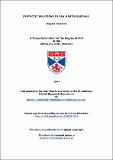Files in this item
Syntactic relations in San Martin Quechua
Item metadata
| dc.contributor.advisor | Mulder, J. W. F. | |
| dc.contributor.author | Howkins, Angela | |
| dc.coverage.spatial | xi, 363 p. | en |
| dc.date.accessioned | 2008-08-14T12:07:28Z | |
| dc.date.available | 2008-08-14T12:07:28Z | |
| dc.date.issued | 1977 | |
| dc.identifier.uri | https://hdl.handle.net/10023/529 | |
| dc.description.abstract | Linguistic description has been described as "the application of a particular linguistic theory to a selected field of linguistic phenomena". The thesis presented here offers a partial application of Axiomatic Functionalism, (partial because its concern is with syntax only), to data collected on the San Martín dialect of Quechua. Proportionate to the whole body of Quechua studies, there has been little produced on the syntax of any Quechua dialect. Most syntactic studies, as do the large majority of phonological and morphological studies, use American methodology, be it based on Bloomfieldian linguistics, or be it based on those of Chomsky. The present methodology stands diametrically opposed to both schools of American linguistics cited above, and as a result introduces a fresh approach to the study of the syntactic aspect of Quechua. With Axiomatic functionalism, a new way of looking at Quechua grammar is presented and thus much of what is accepted "fact" reappraised. For this reason, while the concern of the thesis is with producing a description of syntactic relations in San Martín Quechua under the terms of Axiomatic Functionalism, reference is made to descriptions of other Quechua dialects, most notably where the application of Axiomatic Functionalism produces statements containing certain phenomena which are quite different from statements made on equivalent phenomena in other dialects using a different linguistic theory. Moreover, Axiomatic Fundamentalism is a deductive theory, and so statements regarding the data contained in the description are not statements of "fact", but are hypotheses which may stand as valid hypotheses regarding the data unless they can be refuted. Given that the theoretical base on which the description rests is different from that used in other descriptions of Quechua dialects, and so that the hypotheses made regarding syntactic relations in San Martín Quechua may be tested, Part I of the thesis is given over to the theoretical side of the work: to explaining the relation between theory and description in Chapter I, to giving brief explications of those notions in the theory which have particular relevance for a syntactic description in Chapter II, and in noting some of the limits set to the selection of the data for description in Chapter III./ The axioms and definitions of the theory are given in Appendix A. Part II of the thesis, which is in six chapters, deals with the description proper. Structures which may stand as sentences are established and analysed into their constituent structures, the relations between each constituent being ascertained. Analysis is carried through to the stage where there are no constituents analysable in syntactic terms left. | en |
| dc.format.extent | 13370249 bytes | |
| dc.format.mimetype | application/pdf | |
| dc.language.iso | en | en |
| dc.publisher | University of St Andrews | |
| dc.rights | Creative Commons Attribution-NonCommercial-NoDerivs 3.0 Unported | |
| dc.rights.uri | http://creativecommons.org/licenses/by-nc-nd/3.0/ | |
| dc.subject.lcc | PM6302.H7S9 | |
| dc.subject.lcsh | Quechua language--Syntax | en |
| dc.subject.lcsh | Quechua language--Dialects--Peru--San Martín (Dept.) | en |
| dc.title | Syntactic relations in San Martin Quechua | en |
| dc.type | Thesis | en |
| dc.type.qualificationlevel | Doctoral | en |
| dc.type.qualificationname | PhD Doctor of Philosophy | en |
| dc.publisher.institution | The University of St Andrews | en |
This item appears in the following Collection(s)
Except where otherwise noted within the work, this item's licence for re-use is described as Creative Commons Attribution-NonCommercial-NoDerivs 3.0 Unported
Items in the St Andrews Research Repository are protected by copyright, with all rights reserved, unless otherwise indicated.


